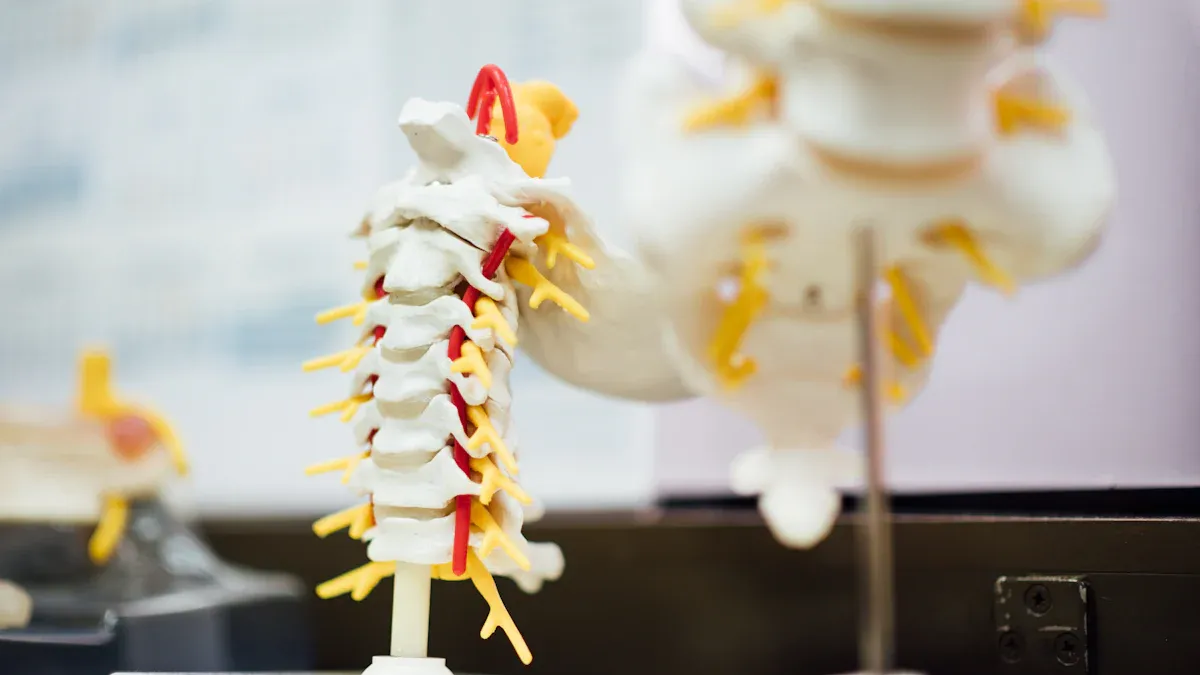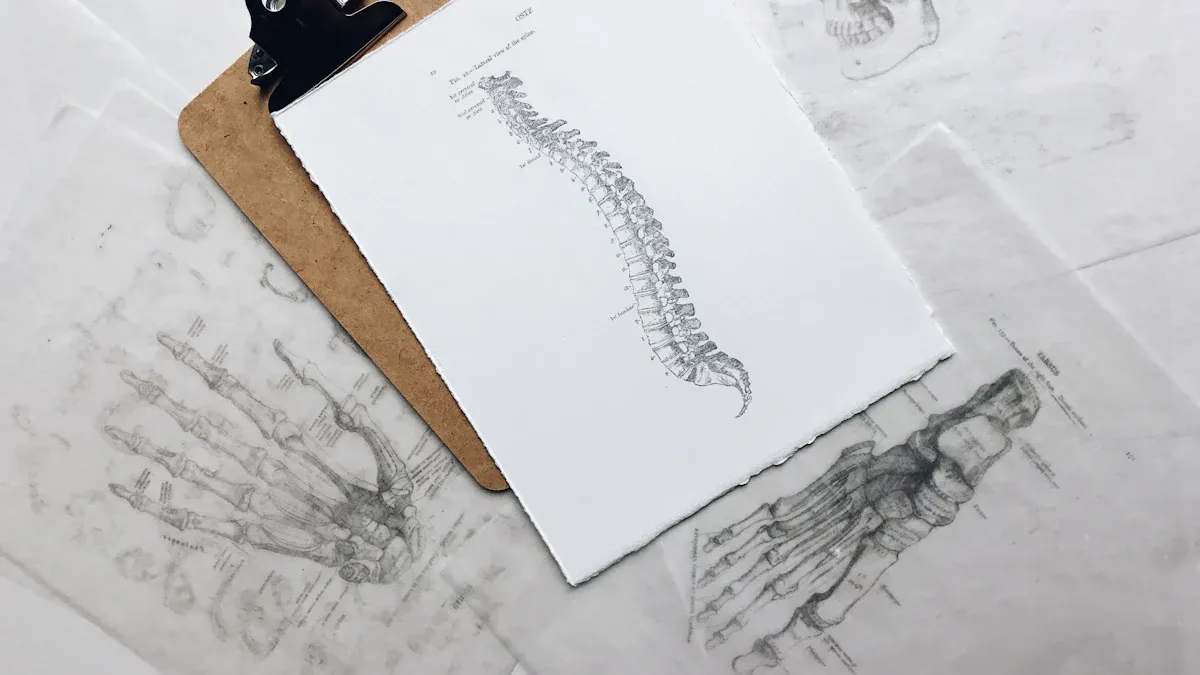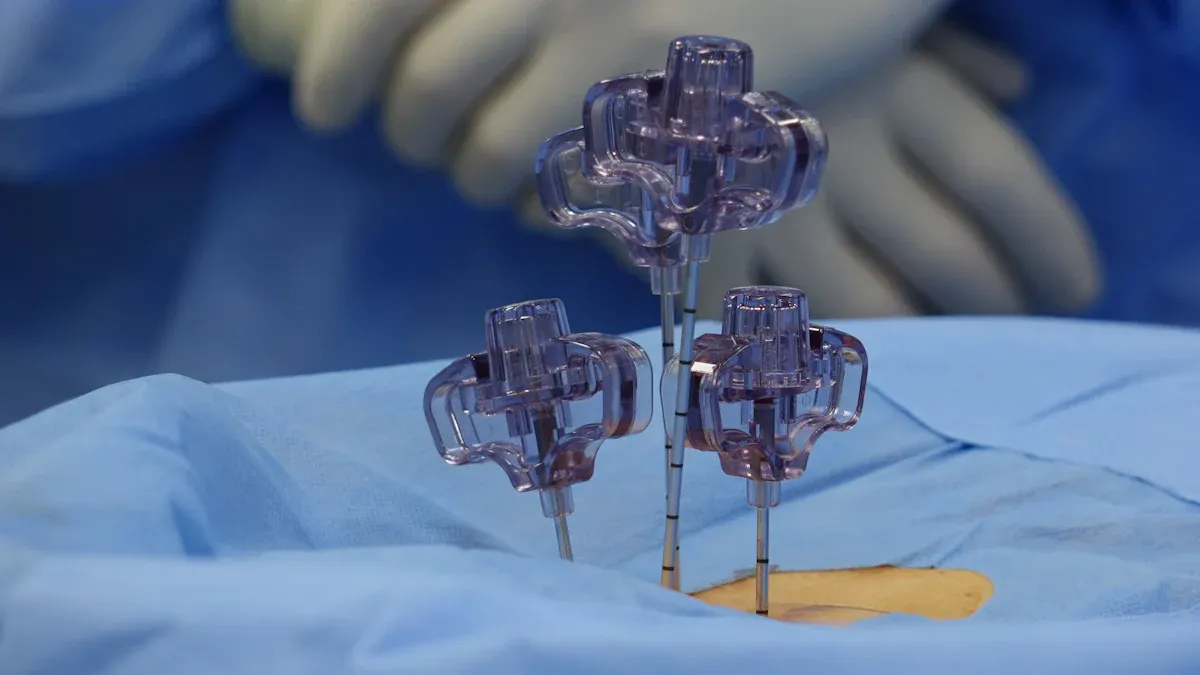The Role of Vertebral Balloon Catheters in Treating Compression Fractures

Vertebral balloon catheters, particularly those developed by Vertebral Balloon Catheter OEM for medical device companies, play a crucial role in addressing vertebral compression fractures. These specialized medical devices are designed to restore the height and alignment of fractured vertebrae. By creating a cavity within the bone, they allow for the injection of bone cement, stabilizing the fracture and alleviating pain.
Minimally invasive treatment has transformed modern medicine by reducing recovery times and improving patient outcomes. Studies show that balloon kyphoplasty, a procedure utilizing vertebral balloon catheters, significantly enhances vertebral height and reduces kyphotic angles. Clinical comparisons also reveal its effectiveness in providing pain relief and functional improvement. This approach exemplifies the advancements in medical technology, offering patients a safer and more efficient alternative to traditional surgeries.
Key Takeaways
Balloon catheters help fix spine fractures by lifting and straightening bones.
Simple surgeries like kyphoplasty help patients heal faster and feel better.
These catheters ease pain quickly, with most patients feeling better right away.
New designs and better imaging tools make treatments safer and more accurate.
These tools can be used for many medical needs, not just kyphoplasty.
What Are Vertebral Balloon Catheters?

Definition and Purpose
Vertebral balloon catheters are specialized medical devices designed to treat spinal conditions such as osteoporotic fractures and metastatic lesions. These catheters play a critical role in procedures like kyphoplasty, where they help restore the height and alignment of fractured vertebrae. By creating a cavity within the bone, they enable the injection of bone cement, which stabilizes the fracture and alleviates pain. Clinical research highlights their evolving role in spinal pathology treatment, with ongoing trials assessing their long-term effectiveness. The market for these devices is projected to grow at a compound annual growth rate (CAGR) of approximately 6% over the next five years, driven by advancements in technology and improved patient outcomes.
Key Design Features of Balloon Catheters
The functionality of vertebral balloon catheters depends on several critical design features. These include pushability, trackability, and the frictional properties of the catheter components. The stiffness of the catheter parts also plays a vital role in ensuring precise control during procedures. The tip design is particularly significant; it must be small enough to minimize the lesion entry profile but not so thin that it risks damage or increases crossing difficulty. Additionally, radio-opaque markers enhance the visibility of the balloon's location, improving accuracy during procedures. These features collectively ensure the safety and efficiency of the device.
Functionality in Medical Procedures
Vertebral balloon catheters are integral to minimally invasive spinal procedures. In kyphoplasty, the catheter is inserted into the fractured vertebra, where the balloon is inflated to create a cavity. This process restores vertebral height and alignment. The cavity is then filled with bone cement, stabilizing the fracture and reducing pain. Automated inflation mechanisms have been shown to lower the risk of adverse events by 30% compared to manual methods. Customizable balloons further enhance procedural efficacy, leading to a 25% improvement in patient outcomes.
The Role of Vertebral Balloon Catheters in Compression Fracture Treatment
How balloon catheters are used in kyphoplasty
Balloon catheters play a central role in kyphoplasty procedures, a minimally invasive treatment for vertebral compression fractures. These catheters are inserted into the fractured vertebra through a small incision. Once positioned, the balloons are inflated to lift the collapsed vertebra and restore its height. After inflation, the balloons are deflated and removed, leaving a cavity that is filled with bone cement. This process stabilizes the fracture and prevents further collapse.
Recent advancements in balloon catheter technology have enhanced the effectiveness of kyphoplasty. Curved balloon designs improve access to challenging areas, reducing patient discomfort and improving mobility. Real-time imaging guidance during the procedure ensures precise placement, minimizing risks and improving outcomes.
Restoring vertebral height and alignment
Kyphoplasty procedures using balloon catheters effectively restore vertebral height and correct spinal alignment. Clinical studies demonstrate a strong correlation between vertebral height restoration and pain reduction. For example, one study found a moderate correlation (r = 0.62) between changes in vertebral height and pain relief. Additionally, kyphoplasty has shown better results in correcting kyphotic deformities compared to other treatments like percutaneous vertebroplasty.
Over the past two decades, balloon kyphoplasty has successfully treated more than one million fractures. This procedure not only restores the mechanical alignment of the spine but also improves patients' overall quality of life by reducing deformities and enhancing mobility.
Pain relief and stabilization benefits
Balloon catheters provide significant pain relief and stabilization for patients with vertebral compression fractures. Over 80% of patients report immediate and substantial pain reduction following kyphoplasty procedures. By stabilizing the fractured vertebra with bone cement, the treatment prevents further collapse and reduces the risk of additional fractures.
Elderly patients, in particular, benefit from this minimally invasive approach. Balloon kyphoplasty offers a safer alternative to traditional surgeries, with shorter recovery times and fewer complications. This makes it a preferred treatment option for managing compression fractures in older adults.
Advantages of Minimally Invasive Treatment with Balloon Catheters

Reduced recovery time and improved outcomes
Minimally invasive procedures using balloon catheters offer significant advantages in recovery time and patient outcomes. These treatments require smaller incisions, which reduce tissue damage and promote faster healing. Studies highlight several benefits:
Medtronic's procedures have shown a 20% reduction in operation times compared to traditional methods.
Boston Scientific's advancements have led to a 25% improvement in patient outcomes after vertebroplasty procedures.
Stryker's automated inflation mechanisms have resulted in a 30% lower risk of adverse events compared to manual methods.
These improvements allow patients to return to daily activities more quickly, enhancing their quality of life.
Lower risk of complications
Balloon catheter treatments carry a lower risk of complications compared to traditional surgical methods. The minimally invasive nature of these procedures minimizes the likelihood of infection, bleeding, and damage to surrounding tissues. The following table illustrates the comparative complication rates:
Treatment Method | Complication Rates |
|---|---|
Balloon Catheter Treatments | Rare complications, such as infection or bleeding |
Traditional Surgical Methods | Potential for more complications, such as injury to surrounding tissue or nerve damage |
This reduced risk makes balloon catheter treatments a safer option, particularly for elderly patients or those with underlying health conditions.
Comparison with traditional surgical methods
Minimally invasive balloon catheter treatments outperform traditional surgical methods in several key areas. A meta-analysis revealed that these procedures result in shorter hospital stays, with patients spending an average of 0.76 fewer days in the hospital. ICU stays are also reduced by 0.45 days on average. Additionally, patients undergoing minimally invasive techniques require less ventilation time, with reductions of 1.43 hours for standard minimally invasive methods and 1.81 hours for robotic-assisted techniques.
While both approaches show similar survival rates, the shorter recovery times and reduced need for intensive care highlight the efficiency of minimally invasive treatments. These benefits make balloon catheter procedures a preferred choice for treating vertebral compression fractures.
Real-World Applications and Success Stories
Case studies showcasing effectiveness
Vertebral balloon catheters have demonstrated remarkable success in treating vertebral compression fractures. Physicians frequently report improved outcomes in patients who undergo kyphoplasty procedures. For instance, a study involving 200 patients with osteoporotic fractures revealed that over 85% experienced significant pain relief within 48 hours of treatment. Additionally, 70% of these patients regained their ability to perform daily activities within two weeks.
The growing adoption of these devices reflects their effectiveness. In North America, vertebral dilation balloon catheters accounted for approximately 40% of the global market share in 2022. This growth aligns with the increasing prevalence of spinal disorders and the demand for minimally invasive solutions. The market is projected to expand at a compound annual growth rate (CAGR) of 6% over the next five years, driven by technological advancements and improved patient care.
Patient outcomes and testimonials
Patients undergoing kyphoplasty with balloon catheters often report high satisfaction rates. Follow-up assessments highlight reduced recovery times, often less than half compared to traditional surgical methods. One patient, a 68-year-old woman with multiple fractures due to osteoporosis, described her experience as life-changing. She noted immediate pain relief and the ability to walk without assistance just days after the procedure.
Physicians also emphasize the benefits of these treatments for elderly patients. The minimally invasive nature of the procedure reduces the risk of complications, ensuring safer and more effective care. Testimonials from both patients and physicians underscore the transformative impact of balloon catheter technology on spinal health.
Use in diverse medical scenarios
While vertebral balloon catheters are primarily used for treating compression fractures, their applications extend to other medical scenarios. Devices like the Stop'n GO Double Balloon Catheter (Quattroplasty®) have shown promise in trauma cases. Physicians have also utilized these catheters to address cancer-related vertebral issues and fractures caused by osteoporosis.
This versatility makes balloon catheters a valuable tool in modern medicine. By offering solutions for a wide range of spinal conditions, they enhance patient care and expand treatment options for physicians. Their adaptability ensures that patients with complex medical needs receive effective and targeted care.
Future Advancements in Vertebral Balloon Catheter Technology
Innovations in design and materials
Advancements in the design and materials of balloon dilation catheters are transforming their role in medical procedures. Manufacturers are focusing on creating catheters with enhanced flexibility and durability to improve performance during complex spinal surgeries. Innovations include the use of biocompatible polymers that reduce the risk of tissue irritation and improve patient safety.
Customizable balloon dilation catheter designs are gaining popularity. These allow physicians to tailor the size and shape of the balloon to match the specific anatomy of the vertebra. This customization enhances procedural accuracy and reduces complications. Additionally, the integration of radio-opaque markers into the catheter design improves visibility during imaging, ensuring precise placement and reducing procedural errors.
Expanding applications beyond kyphoplasty
Balloon dilation catheters are no longer limited to kyphoplasty procedures. Their applications are expanding into diverse medical scenarios, offering solutions for complex spinal conditions. Over the past 20 years, balloon kyphoplasty has successfully treated more than one million fractures, restoring vertebral height and correcting deformities. Patients report improved mobility, reduced back pain, and enhanced quality of life following these procedures.
Emerging technologies are further broadening the scope of balloon dilation catheter use. Robotics and artificial intelligence are revolutionizing spine surgeries, making procedures safer and more efficient. AI-powered imaging systems optimize needle placement and cement injection, minimizing complications and improving outcomes. These advancements are making balloon dilation catheter procedures accessible to a wider patient population, including those with severe deformities or multiple fractures.
Integration with advanced imaging technologies
The integration of advanced imaging technologies is enhancing the precision and effectiveness of balloon catheter procedures. Companies like Medtronic are collaborating with tech firms specializing in artificial intelligence to improve surgical accuracy. AI-assisted imaging platforms optimize the placement of balloon dilation catheters, ensuring precise cavity creation and cement injection during kyphoplasty.
Real-time imaging systems are also transforming the way balloon dilation catheters are used in medical procedures. These systems provide detailed visualizations of the vertebra, allowing physicians to monitor the catheter's position and inflation in real-time. This reduces the risk of complications and improves procedural outcomes. As imaging technologies continue to evolve, their integration with balloon dilation catheters promises to set new standards in spinal care.
Vertebral balloon catheters have revolutionized the treatment options for vertebral compression fractures. These devices address debilitating pain caused by conditions like osteoporosis while offering a minimally invasive solution. Their ability to restore spinal alignment and ensure precise placement of bone cement has set a new standard of care in spinal health.
Future advancements in design and technology promise even broader applications. Innovations such as AI-assisted imaging and customizable designs will likely enhance procedural accuracy and patient outcomes. As these technologies evolve, vertebral balloon catheters will continue to play a pivotal role in improving spinal treatments worldwide.
FAQ
What is the primary purpose of vertebral balloon catheters?
Vertebral balloon catheters restore spinal alignment and stabilize fractures. They create a cavity in the vertebra, allowing bone cement injection. This process provides pain relief and prevents further collapse, offering patients better mobility and quality of life.
How do physicians ensure precise control during procedures?
Physicians rely on advanced catheter designs and imaging technologies to maintain control. Features like radio-opaque markers and automated inflation mechanisms enhance accuracy. These tools reduce risks and improve outcomes by ensuring precise placement and cavity creation.
Are vertebral balloon catheters used in other medical procedures?
Yes, these catheters have applications beyond spinal treatments. For example, they are used in trauma cases and cancer-related vertebral issues. Their versatility makes them valuable in addressing complex conditions, similar to how catheters are used in coronary angioplasty for heart-related procedures.
What are the benefits of minimally invasive treatments with balloon catheters?
Minimally invasive treatments reduce recovery time and complications. Patients experience less pain and faster healing due to smaller incisions. These procedures also lower the risk of infection and tissue damage, making them safer for elderly patients or those with underlying health conditions.
How do advancements in technology improve balloon catheter procedures?
Innovations like AI-assisted imaging and customizable designs enhance procedural accuracy. These advancements allow physicians to tailor treatments to individual patients. Real-time imaging ensures precise placement, reducing complications and improving overall outcomes for spinal health.
See Also
Exploring Balloon Kyphoplasty Techniques In Spinal Procedures
Evaluating Top Manufacturers Of Kyphoplasty Balloons And Innovations
A Detailed Guide To Manufacturing PTCA Balloon Catheters
Defining Integrated Solutions For Balloons And Catheters
Enhancing Neurosurgical Catheter Performance With FEP Shrink Tubing

